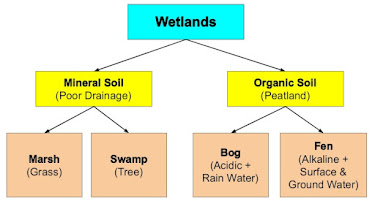Wetland
Wetlands are distinct ecosystems saturated/flooded by water(permanently or temporary). Wetland systems are generally shallow water system.
In wetland ecosystem, the shallow water level and anaerobic(no oxygen) soil make it a distinct ecosystem from land ecosystem and aquatic ecosystem. Wetland ecosystems are distinct from land and aquatic ecosystems in terms of vegetation. It support the vegetation that tolerate shallow water and anaerobic soil conditions.
Wetland, biodiversity rich region act as a transition zone(ecotone) between land and aquatic ecosystems. It also act as carbon sink system, thus playing important role in combating climate change.
Types of Wetland
There are various way to define wetland ecosystems like
Water type- freshwater, brackish water and saltwater wetland.
Water source- Tidal, estuaries, floodplain, rainfed wetland
But we will learn types of wetland based on soil type and other characteristics.
Wetland(Mineral soil)
In this type wetland, the soil is dominated by minerals but has poor drainage characteristics. Generally associated with warm climate.
Marsh- these wetlands are dominated by grass ecosystems and can be further classified into freshwater, brackish water and saltwater Marsh.
Swamp- these wetlands are dominated by trees(swamp tree) ecosystems and can be further classified into freshwater, brackish water and saltwater Swamp.
Wetland(Organic soil)
In this type wetland, the soil is dominated by organic materials. And wetland with organic soil is commonly known as Peatland. Generally associated with cold climate.
Bog- these wetlands are acidic in nature and fed by rain water.
Fen- these wetlands are alkaline in nature and fed by surface and ground water.
Wetland Conservation
Ramsar Convention
Signed on 2nd February 1971(2 Feb- International wetland day) in the Iranian city Ramsar. As the convention was signed at Ramsar, it was named as Ramsar convention. This convention entered into force in 1975.
Under this convention wetlands of international importance are designated as Ramsar site.
Montreux Record- Adopted at Montreux(Switzerland) in 1990. A register of wetland sites listed under Ramsar convention and needed immediate attention.
Indian sites in Montreux Record- Keoladeo National Park(Rajasthan), Loktak lake(Manipur)
Chilika Lake, Odisha(1993-2002)
Ramsar sites in India- 93(Oct, 2025)
1st Ramsar sites in India- Chilika lake, Odisha
Largest Ramsar sites in India- Sundarbans, West Bengal
Smallest Ramsar sites in India- Renuka Lake, Himanchal Pradesh(2005-2022)
From 2022, Vembannur Wetland Complex, TN became smallest Ramsar site of India
State with maximum number of Ramsar sites in India- TN(20), UP(10)
Other Data
Wetland- 4% of world geographical area
Wetland(India)- 4.63% of India's geographical area
Wetland(India) - Gujarat > Andhra Pradesh > UP > West Bengal
Country with highest number of Ramsar Site- UK
1st Ramsar Site(1974)- Cobourg Peninsula(Australia)
Largest Wetland- Pantanal(Brazil, Bolivia, Paraguay), only 5% of Pantanal is protected
Largest Ramsar Site- Rio Negro(Brazil)
World’s largest protected wetland area- Bolivia
Carlson's index
It refers to Trophic state of a body of water and is defined as the total weight of biomass contained within water body.
Tropic classification of water bodies
- Oligotrophic
- Mesotrophic
- Eutrophic and Hypereutropic


Comments
Post a Comment